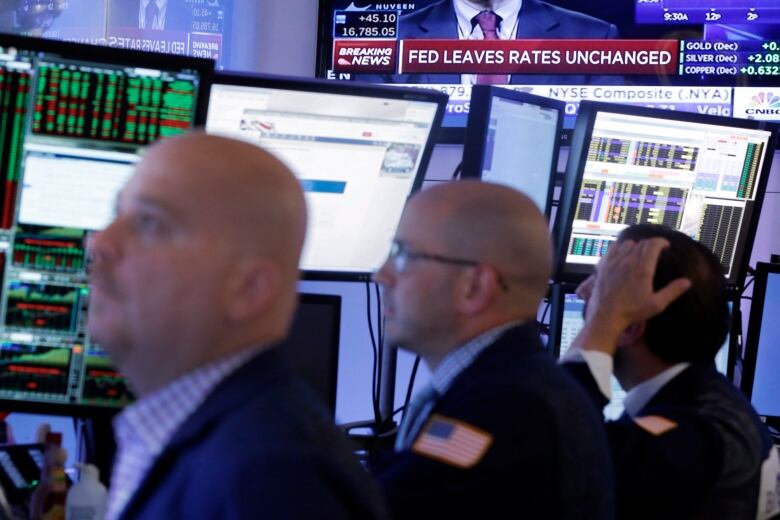Canadian dollar above 76 cents US as oil surges to 1-year high
Bonds sell off pushing yields higher, as markets anticipate Fed rate hike this week

The Canadian dollar stayed firm above 76 cents US on Monday after oil prices touched an 18-month high.
The impetus for the rise in crude was an agreement between the Organization of the Petroleum Exporting Countries and key non-OPECcrude producersto cut output.
At a weekend meeting, 11 non-OPEC producers agreed to cut 558,000 barrels a day of crude output in the six months beginning Jan. 1. As well, Saudi Arabia's oil minister hinted that it was considering further production cuts, on top of the 486,000 barrels aday to which it has already committed.
Last month, OPEC countries agreed to cut 1.2 million barrels a day from their output, which has left the world flooded in oil and depressed oil prices.
In indications that OPEC members are serious about reducing production, Iraq said Monday it was in discussions with foreign companies operating its giant southern fields to implement some cuts during scheduled maintenance.
Brent futures, the main international contract, soared more than fiveper cent to top $57 US a barrel in European trading for the first time since July 2015. But the rally was short-lived and it slipped back in North American trading to $55.53 a barrel. That's still a twoper cent gain from Friday.
West Texas Intermediate, the benchmark North American contract, closed at $52.83 a barrel, up $1.33from Friday and shy of the $54 it reached overnight.
Those are the highest prices in 18 months, and lit a fire under the Canadian dollar and energy stocks.
A bounce for the loonie
The Canadian dollar is now at 76.14cents US, up two cents against the strong U.S. dollar since OPEC first reached a deal on production cuts. It rose 0.27of a cent since Friday.
- Oil industry teetered 'close to bankruptcy,' but experts see signs of hope
- Non-OPEC oil producers to cut output 558,000 barrels a day
The loonie is still vulnerable, as the Fedisexpected to raise interest rates later this week for only the second timesince the global financial crisis.
Jimmy Jean, senior economist at Desjardins, points to the discrepancy between the ebullient dollar and rising stock pricesand the subdued forecast for the economy given by the Bank of Canada.
"Rather than adjusting to the warnings of Governor Stephen Poloz, markets are inviting him to toast to Donald Trump," he said in a note to clients.
Jean warns the Canadian dollar and bond yields are vulnerable to the Fed's move and could be knocked back as Poloz leaves rates where they are or even cuts them.
Markets have built in an expectation of a stronger U.S. dollar, as the Fed has sent signals it will raise its benchmark rate this week by 0.25 per cent.

The U.S. dollar rose toits highest since February against the Japanese yen, which was also hurt by rising oil prices.
The Norwegian crown and Russia ruble, both heavily influenced by oil prices,were also big gainers from the oil deal. Theruble rose almost twoper cent against both the U.S. dollar andeuro.
- Non-OPEC oil producers to cut output 558,000 barrels a day
- ANALYSIS |OPEC could lose market share in a world awash in oil: Don Pittis
The S&P/TSX composite index fell 24.50 points at 15,287.70, weighed by losses from the industrials sector. However, the TSX is up 17 per cent on the year.
In New York, the Dow Jones industrial average rose 39.58 points, or 0.2 percent, to 19,796.43, another record high close.
The S&P 500 and the Nasdaq composite index both lost ground on Monday.
Bond markets in contrast were under heavy pressure. Eurozone government bond yields opened sharply higher with Germanbonds up fivebasis points at 0.40 per cent as U.S.yields topped 2.5 per cent for the first time sinceOctober 2014.
The yield on U.S. Treasuries widened in anticipation of further inflation pressure.
Rising bond yields could mean higher borrowing costs ahead.
Emerging markets are already bracing for a difficult run ifU.S. rate hikes push up the dollar and global bond yields.
Gold, meanwhile, which had a bumper first half of 2016, hitits lowest level since early February at $1,152 US an ounce, before the precious metal closed the day with a gain of $3.90 at$1,165.80 US an ounce.
With files from Reuters, The Canadian Press












_(720p).jpg)


 OFFICIAL HD MUSIC VIDEO.jpg)
.jpg)



























































































